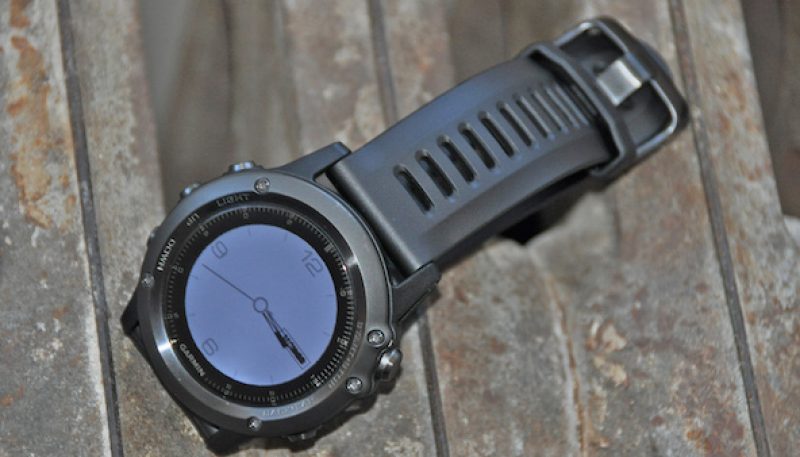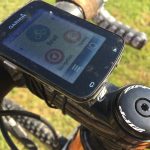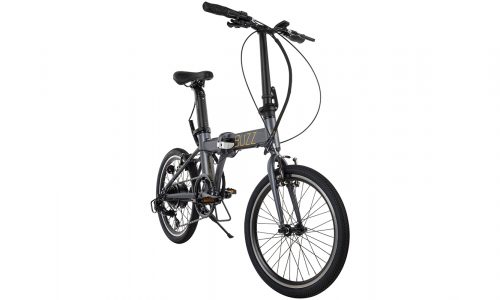Home » Gear Reviews » Biking » Bike Computers » Garmin Fenix 3 Sapphire (Ant+)
Garmin Fenix 3 Sapphire (Ant+) Review
May 7, 2015















 93
93 The Good
- Sharpest screen in group
- Deep selection of cycling and multisport functions
- Highly programmable
- Fashion-forward with many watch-mode options and “smart watch” functions
- Multiple sport modes and bike profiles
The Bad
- Very glitchy Bluetooth and Wi-Fi (should be addressed in software updates)
- No dual-pedal power readout
- Screen too dark unless using backlight
- Heaviest in group at 3 oz (6.5 oz with metal strap)
- Poorly designed route guidance zoom function
The Garmin Fenix 3 is the first fully functioning cycling and multisport computer that’s as fitting on a bike as it is at a dinner party. With a full range of cycling functions, multiple power screens, full navigational functions (including route guidance), and one-touch weather and altitude info, this unit is ready for serious on- or off-road adventures. Unfortunately, at this time some of the Wi-Fi and Bluetooth connectivity is quite problematic. Still, the Fenix 3 is a good choice for cyclist who want deep, analytical data about their workouts.
Cycling-Specific Functionality
There may not be as many options for analytical cycling data as a full head unit, but the Fenix 3 has a surprising range of in-depth features and readouts—more than enough to fully satisfy this very tech-savvy tester. We counted 73 main screen options in all (plus some sub-fields), 12 different HR, and about 27 power screens. With its advanced navigation tools and programmable route-guidance, it would be very difficult to lose your way in the backcountry wearing this watch. You can also plan routes, or borrow others’ routes and follow them, with basic turn-by-turn directions. The Fenix has a balance percentage reading, however it lacks separate pedal vector readouts, which allow you to see how efficiently you’re pedaling—a feature some testers missed.
With ANT+ capability, the unit quickly pairs with various sensors including power, speed and cadence, HR, and running pods. The pairing is very easy and reliable, and we never lost a signal once paired. Best of all, it keeps multiple units in its memory, so if you have three different power meters (yes some of us do!) there’s no need to re-pair each time. Plus profiles can be added as needed, along with the 12 presets (including two bike and one triathlon), so if you have three bikes you won’t need to adjust the sensors each time you switch rigs.
But there’s one area where the Fenix 3 takes a major step backwards from the Forerunner 910 and 920 series. Garmin’s route guidance helped set the 910xt apart from most of its competitors, and while rudimentary in comparison to head units, it was everything you needed to explore new routes, or plan routes in new cities. And one of its most effective features was the ability to zoom in/out multiple times on the route, and your specific location on it, so you could see turns clearly or see where you were in the route.
I’m not sure why, but Garmin changed the navigation in the Fenix 3, and it’s not quite as smooth nor as quick as the previous version, but thankfully it is less prone to freezing and glitches. However the zoom function on the guidance is poorly designed—once zoomed, the “tracking arrow” would move out of the frame, so there was no way to know your location on the route. The system is basically useless without this because the default zoom is too far out. This has been fixed on the 920xt, but not yet on the Fenix 3.
GPS Functionality
Like the Forerunner 920xt, the Fenix 3 is quick to pick up a signal and rarely loses it, even in deep forests. Signal is especially reliable when using the GLONASS option, which works along with GPS, but cuts battery life significantly. Even when it did lose a signal, it usually regained it quickly enough to stay on track. In testing, the Fenix wasn’t as quick and reliable as the Suunto Ambit 3, but definitely the best of the other devices tested. It has more complete navigation features than the 920, that hardcore mountain bikers will love—a 3-axis electronic compass with bearing screens (functional even when not moving), a site-and-go option, and a backtrack.
Ease of Use and Display
With its 218 x 218 pixel display, behind a sapphire lens, the Fenix 3 had the sharpest readout of any sports watch I’ve ever tested. It looked more like a smartphone screen than a watch—even the tiniest words and icons were clearly visible. However, visibility is only good when pressing the backlight button. Even at the highest setting, the normal display is too dark to see in anything but direct light. We recommend using a white background and setting it to stay on, especially when on the bike or in other training. However this will drain the battery quicker—in my test the battery lost 7% in one hour with the light on—so remember to turn it back to a 15 or 30 second timeout.
The options for screen layout and fields are plenty, with up to four per field—all easy to read and also easy to change during a workout. The buttons are a bit less intuitive than the Forerunner 920xt, but still easy to discern and push, even with most cycling gloves (although heavy winter gloves provided a challenge). With the wide array of data options for power, HR, cadence, etc., I can’t imagine anyone needing more on-the-fly data than this watch can provide (other than separate pedal power readings and vectors).
Battery Life
Garmin claims up to six weeks of battery life in basic watch mode, but in testing we found this to be unrealistic. Any playing with the watch (turning on/off backlight, etc.), will cut that number—but we still got about three or four weeks under normal use (without recording). With GPS recording in Ultra Trac mode—signal taken about once per minute—their estimate is up to 50 hours, enough battery for 24-hour or multi-day racing with very low relative accuracy. On normal GPS mode, which is more like once per second, that number drops to 20 hours, which will cover just about any bike event or triathlon. We couldn’t find an estimate for GPS + GLONASS, but it will probably be a few hours less still.
Online Training Support
We found Garmin Connect—the online training support program for all Garmin athletic products—to be among the most advanced and user-friendly of all the sites tested. It is very reliable, almost never times out, and loads quickly, unlike some of the others we used. Garmin Connect is better for the analysis of the actual training data, training and route planning, editability, etc. Individual color graphs display multiple data clearly and are all able to pop-out for better viewing. Accompanying data boxes have all the numbers, and are all editable after the fact. Info can also be added/deleted easily.
I found the route planning on GC to be even better and easier than Ride With GPS or Map My Ride—and far superior to other watch brands’ sites. Routes are simple to plan, quick to load, and highly editable. My main complaint with the site is that training activity is not easily shared with other programs. You can upload some other training data, but only .tcx, .gpx, and .fit files, and we found the upload/download process quite glitchy, even with those file types.
Value
At $600 the Sapphire model is the highest-priced in our test group. It includes two watchbands (a rubber sports band and a metal lifestyle option), a sapphire lens, and it doubles as a fashion watch, making it a strong value for the price. An extra $100 will get you Garmin’s HRM-Run strap which provides basic HR info, plus comparative running cadence and other data. The strap is waterproof, but because it’s ANT+ it will not provide swimming signal.
For the strictly sporty types, the non-sapphire model is $550 and includes the HR strap ($500 without). Truly an excellent value compared to the other devices in the group.

















